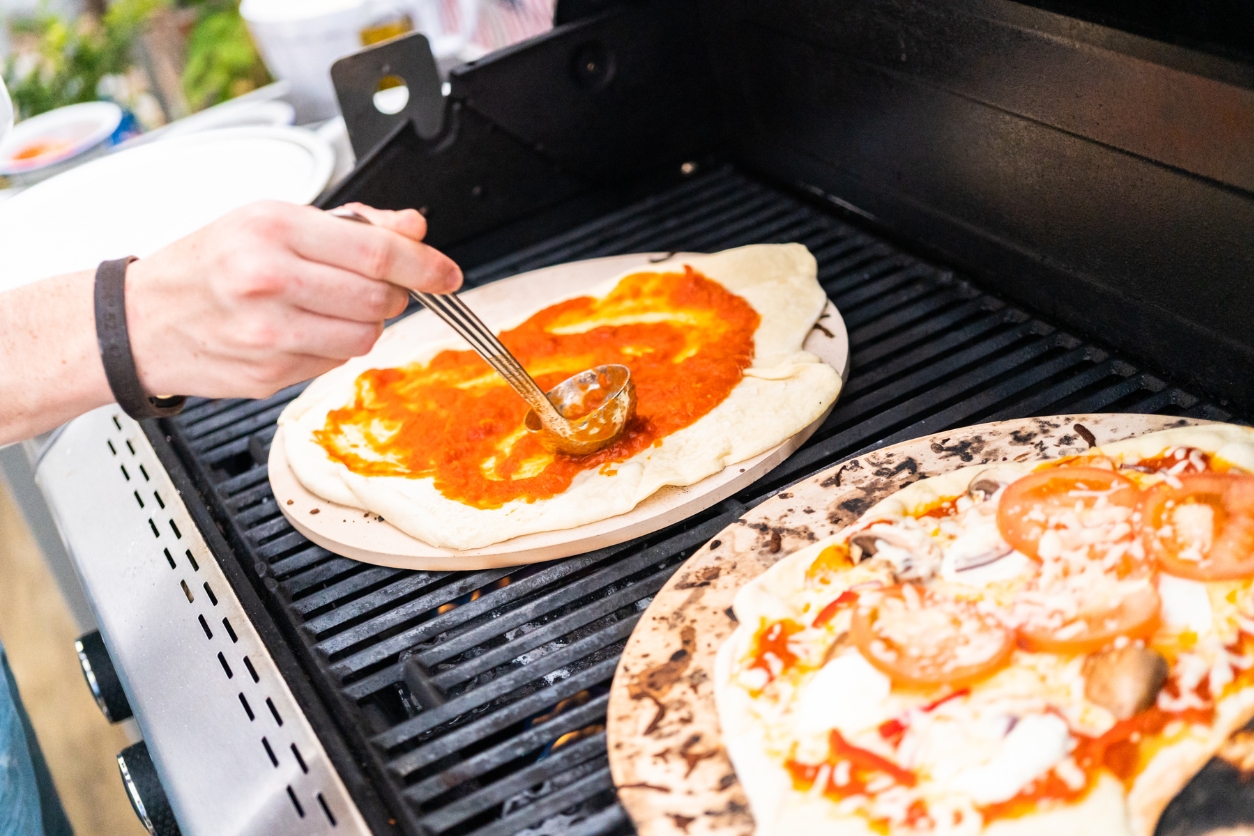Making the perfect grilled pizza at home is an art that’s worth mastering, especially if you’re looking to bring a bit of that smoky, outdoor flavor into your pizza-making. The grill yields a unique texture and char that’s hard to achieve in a regular kitchen oven, giving your pizza a character all its own. But grilling pizza takes a bit of finesse—you’re working with direct heat, often high temperatures, and a dough that’s all too easy to burn if you’re not careful.
Grilling pizza is all about understanding your setup, choosing the right ingredients, and knowing how to handle dough on the grill. Here are some tips to get it right.
Make the Dough Less Hydrated

When it comes to grilled pizza, dough is everything. You want a dough that’s pliable but won’t fall apart under the heat, which means it needs a bit more structure than your average pizza dough. If you’re making it from scratch, aim for a dough that’s slightly less hydrated than one you’d use in the oven—this helps it hold up on the grill’s open flame. Many store-bought options will work, too, especially if they’re labeled for high-heat cooking.
After kneading your dough and letting it rise, roll or stretch it out on a floured surface. Keep it relatively thin; a thick crust can be hard to cook evenly on a grill. Don’t worry too much about getting a perfect circle or rectangle—grilled pizza has a rustic charm, and an irregular shape adds to the appeal. When you’ve got your shape, let it rest for a minute or two before taking it to the grill.
Pre-Heat Your Grill
Grilling pizza requires a well-preheated grill, whether you’re using charcoal, gas, or pellet. Start by preheating your grill to a medium-high temperature, around 400–450°F. For a charcoal grill, arrange the coals on one side to create a hot zone and a cooler zone; this allows you to move the pizza to a cooler area if it’s cooking too fast. Gas grills offer a bit more control, as you can adjust the burners to maintain an even temperature.
If you have a pizza stone that’s safe for the grill, it’s worth using—it absorbs the heat and gives you that beautiful, crispy base. Place the stone on the grill as it heats up, giving it plenty of time to preheat along with the grill itself. If you don’t have a stone, grilling directly on the grates works just as well, but you’ll need to keep an eye on the dough to avoid burning.
Don’t Let the Pizza Stick to the Grill

The trickiest part of grilling pizza is getting the dough on the grill without it sticking or tearing. Lightly brush one side of the dough with olive oil, then place it on the grill, oiled side down. Brush the top with oil as well to prevent it from sticking when you flip it. Close the lid and let the dough cook for about 2–3 minutes—just long enough to develop grill marks and a slightly firm base.
Once you see bubbles forming and the underside has some color, it’s time to flip. Use a pizza paddle or grill tongs to gently turn the dough, being careful not to tear it. Now, you’ve got a base that’s ready for toppings.
Perfect the Grill Time
Grilling pizza isn’t an exact science—it’s more about watching and adjusting as you go. After flipping and topping the pizza, close the lid and cook for another 3–5 minutes, depending on your grill’s heat and the thickness of your crust. The goal is to get a golden-brown crust with some charred spots for flavor.
If your grill has a temperature gauge, aim to keep it steady, but don’t hesitate to move the pizza to a cooler area if it’s cooking too fast. A final check: lift one edge of the pizza with a spatula to peek at the underside. When it’s golden and crisp, your pizza is ready to come off the grill.
Don’t Go Overboard with the Toppings

When it comes to toppings, less is often more on a grilled pizza. Since grilling is faster than oven-baking, toppings don’t have as much time to cook through. Stick to ingredients that are thinly sliced or precooked, as thicker cuts may not fully cook before the crust is done. Classic toppings like mozzarella, pepperoni, and fresh basil work well, but grilled pizza is a great canvas for experimentation—think thin slices of zucchini, pre-grilled mushrooms, or even a handful of fresh arugula added after cooking.
When adding sauce, keep it light; too much can weigh down the dough and make it soggy. For the cheese, go with a low-moisture mozzarella, which melts well without releasing too much water. If you’re using a more delicate cheese like ricotta or burrata, add it after the pizza is off the grill to avoid overcooking.
